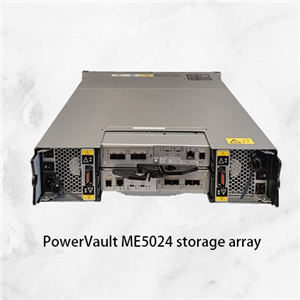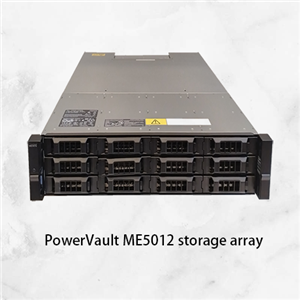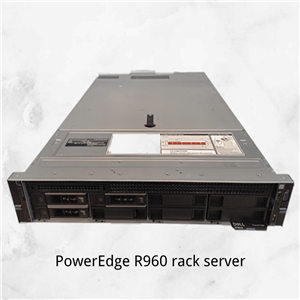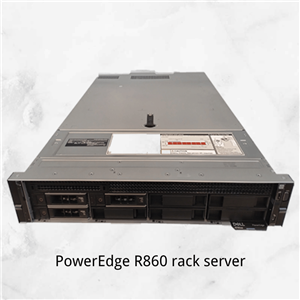How to Set Up and Optimize Dell PowerEdge Tower Servers
To ensure your dell poweredge tower server operates seamlessly from day one, it’s important to understand the capabilities of models like the dell poweredge r630, dell poweredge r740, and dell r960. These dell poweredge servers are designed for high performance and reliability, while the dell me5024 enhances your storage infrastructure with robust features. Setting up a dell poweredge environment requires thoughtful planning and attention to detail. Consider the following metrics:
Metric | Value |
Number of servers in rack | 4 |
Power consumption | 20 to 40 kW |
Number of cables | More than 100 |
Total weight | Over 1000 lbs |
Weight per server | Over 200 lbs |
With numerous cables and substantial equipment, having a structured approach is essential. serverscn.com provides comprehensive tools and resources to help you deploy and manage your dell poweredge servers, including the dell poweredge r630, dell poweredge r740, dell r960, and dell tower server models, as well as storage solutions like the dell me5024. Whether you’re an IT professional or new to server management, you can rely on step-by-step guidance to streamline your server deployment process.
Key Takeaways
· Pick the Dell PowerEdge server model that fits what you need now and later. This helps you get good performance and easy upgrades.
· Set up your server with care. Check all the parts. Put it in a cool and steady place. Connect the cables neatly. This helps your server work well.
· Use tools like iDRAC and LifeCycle Controller to control your server from far away. These tools help you update firmware and set up faster. They also help you make fewer mistakes.
· Update your server’s firmware, drivers, and operating system often. This makes your server faster, safer, and more stable.
· Make your server better with serverscn.com products and accessories. These help with cooling, power, and network speed. Use monitoring tools to find problems early.
Dell PowerEdge Features
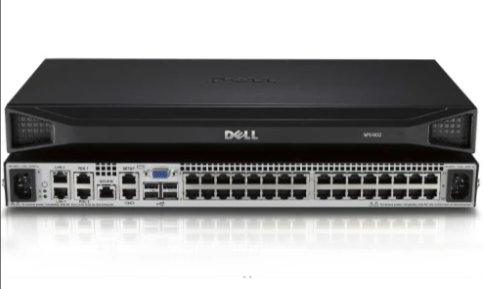
Model Overview
There are many Dell PowerEdge tower servers to pick from. The R630 and R640 are small, so they save space. The R740 and R750 work well for virtualization and databases. The R760 and R960 are strong for tough jobs. The ME5024 is made for storage and handles lots of data quickly. Each model lets you choose different processors, memory, and storage. This helps you build a server that fits your needs.
Tip: Think about what you need now and later when picking a server. Dell PowerEdge models can be upgraded. You can add more parts as your business grows.
Performance and Scalability
Dell PowerEdge servers work fast and do well on tests. The R760 gets high marks for AI and business apps. The R750 and R640 are good for virtualization and databases. The table below lists some tests used to check these servers:
Benchmark Type | Description | Example Models |
SPEC CPU 2017 | CPU compute performance | R640, R750, R760 |
TPC-H | Decision support queries | R640, R750, R760 |
MLPerf | AI inference/training | R760, R750 |
VMmark | Virtualization | R760, R750 |
These servers can run websites and big data jobs. Dell PowerEdge servers are easy to upgrade. You can add more memory, storage, or network cards when you need them.
Security and Management
Dell PowerEdge servers have strong security features. Many layers of security keep your data safe. The iDRAC tool lets you check and control your server from far away. LifeCycle Controller helps you update and fix your server easily. Dell checks every part to make sure it works well for a long time. This keeps your server running, even in hard places. Dell PowerEdge servers are known for being reliable. Many businesses in healthcare, finance, and education use them.
Server Setup Steps
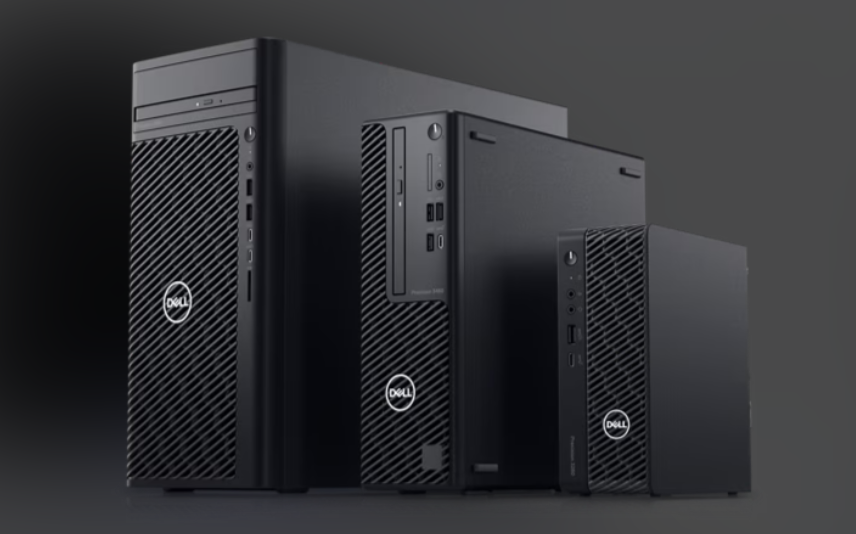
Unboxing and Inspection
Start by opening the box slowly and carefully. Look at the box and see if it is damaged. Take out the server and all the accessories. These include cables, rails, and papers. Put everything on a clean, flat table. Check the outside of the server for dents or marks. Make sure all the ports and slots look good. Count all the parts you got. Match them with the packing list. If something is missing or broken, tell your supplier right away.
Tip: Take pictures of the server and accessories while you open the box. These photos can help if you need to report a problem with shipping.
Placement and Connections
Pick a spot that can hold the server’s weight and size. Make sure the place has good airflow and stays cool. Do not put the server near things that make heat or in the sun. Use a strong rack or shelf to hold the server. Fasten the server so it does not move.
For best results, set up your network and power carefully:
· Use neat cabling to keep wires tidy and avoid signal loss.
· Make sure you have steady power and backup like UPS units.
· Set up cooling to stop the server from getting too hot.
· Put workloads close to users when you can. This makes things faster.
· Connect to a network using new designs like leaf-spine for fast and easy growth.
· Watch network numbers like latency, packet loss, and bandwidth to keep things running well.
· Use extra connections so one problem does not stop everything.
· Add security like firewalls and network segments to keep data safe.
Note: Good placement and strong connections help your dell poweredge server work well and stay protected.
Power-On Process
After you connect all the cables and check your work, you can turn on the server. Plug the power cable into a safe outlet. Press the power button on the front of the server. Look for lights to turn on. Listen for the fans to start spinning. The server will check itself. If you see warning lights or hear beeps, look in the manual for help.
When the server starts, connect a monitor and keyboard if you need them. You can also use remote tools like iDRAC to set up the server. Wait for the first boot to finish. Now you are ready to set up the server.
Tip: Always check your cables before turning on the server. This helps stop hardware problems and gives you a smooth start.
Dell PowerEdge Initial Configuration
Setting up your server the right way helps you avoid problems. It also saves you time. You can use tools like iDRAC, LifeCycle Controller, and BIOS settings. These tools help your server work well from the start. These steps help you get the most out of your dell poweredge server.
iDRAC Setup
iDRAC means Integrated Dell Remote Access Controller. This tool lets you control your server from anywhere. You can turn the server on or off. You can check its health and change settings. You do not have to be in the server room. iDRAC makes remote management simple and quick.
When you set up iDRAC, you can see over 180 different metrics and sensors. These show things like power use, temperature, CPU load, and memory use. iDRAC sends this data in real time. You will not miss important changes. You can connect iDRAC to tools like Prometheus or Splunk. This helps you look at the data more closely.
Here is a table that shows what you can watch with iDRAC and other Dell tools:
Solution | Domain | Key Performance Metrics and Features | License Requirements |
iDRAC GUI | Single server basis on iDRAC GUI | Power utilization, thermal data, CPU utilization %, memory bandwidth usage, system utilization, temperature probes | iDRAC Express License and above |
OpenManage Enterprise Power Manager | Multiple Dell PowerEdge servers and VxRail nodes | Power, thermal, CPU utilization %, memory bandwidth %, overall system utilization %, GPU telemetry | OME Advanced License, Optional iDRAC Data Center License |
APEX AIOps Infrastructure Observability | Multiple Dell PowerEdge servers, VxRail nodes, and other Dell infrastructure | Power, thermal, performance, NIC traffic, Fibre Channel HBA traffic, NVMe I/O data, GPU data, anomaly detection, forecasting | iDRAC Datacenter License |
iDRAC Streaming to 3rd Party solutions | Multiple Dell servers to 3rd party software | Comprehensive server data including GPU and OS metrics, supports integration with non-Dell telemetry | iDRAC Datacenter License |
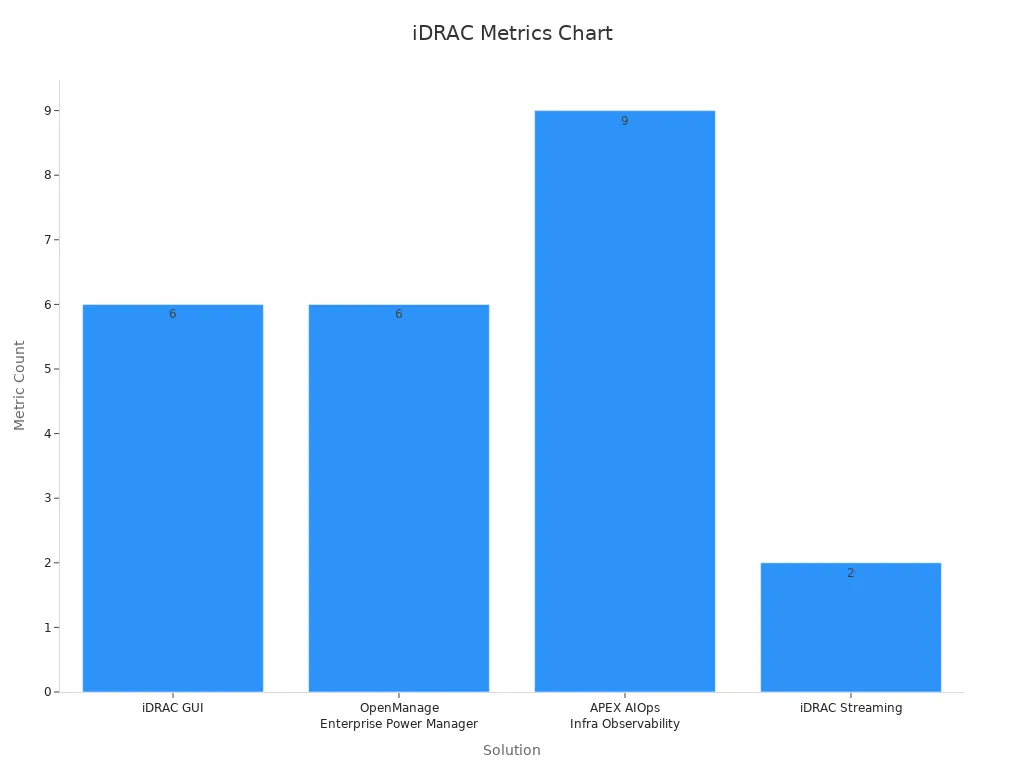
You can use iDRAC to manage many servers at once. The data goes straight to your monitoring tools. You do not have to worry about missing anything. This setup helps you find problems early. It keeps your servers running well.
Tip: Make a strong password for iDRAC and change it often. This keeps your server safe from people who should not get in.
LifeCycle Controller
LifeCycle Controller is a tool built into the server. It helps you set up and update your server. You can use it to install an operating system. You can also update firmware and save your settings. LifeCycle Controller gives you steps to follow. You do not have to guess what to do next.
Setting up servers by hand takes a long time. It can lead to mistakes. Studies show that manual setup has a high error rate. It can take 4 to 6 hours to set up each server by hand. Using tools like LifeCycle Controller is much faster. You can finish setup in minutes. You will make fewer mistakes. Automated setup almost stops errors and gets your server ready quickly.
To use LifeCycle Controller, press F10 when the server starts. You will see a menu with choices for setup, updates, and fixing problems. Follow the steps to finish each job. You can also save your settings. This helps if you need to set up more servers later.
Note: Always look for firmware updates before you install your operating system. New firmware helps your server run better and stay safe.
BIOS Settings
BIOS stands for Basic Input/Output System. It controls how your server starts. It also controls how it uses hardware like the CPU and memory. Changing BIOS settings can help your server run faster.
Technical studies show that changing BIOS settings can make your server work better. The "HPC Profile" is a good setting for high-performance computing. You can use RACADM commands to set this profile. This gives you the best results for your work.
· Studies tested 15 BIOS settings on Dell PowerEdge 16G servers with Intel Sapphire Rapids processors.
· The "HPC Profile" makes the server faster, especially for hard jobs.
· HPL tests show the 8480 processor can run up to 1.65 times faster than the 6430 with the HPC Profile.
· STREAM tests show better memory speed, with the 8452Y and 8480 processors running 1.12x and 1.24x faster than the 6430.
· HPCG tests show the 8452Y and 8480 processors work 1.02x and 1.12x better than the 6430.
· OSU tests for MPI communication show small changes, within 1-2%, across BIOS settings.
· BIOS tuning changes performance by 1-3%. The HPC Profile gives the best results.
· You can change BIOS settings from far away with RACADM commands. This makes it easy to set up many servers at once.
Tip: Write down your BIOS changes. This helps you remember what works best if you set up another server.
By following these steps, you can set up your server fast. You will avoid common mistakes. You will get the best performance from your hardware.
Operating System Install
Supported OS
You can pick from many operating systems for your Dell PowerEdge server. Most people use Windows Server or Linux. Models like the R630, R640, R740, R750, R760, R960, and ME5024 work with lots of operating systems. Here are some you can use:
· Windows Server 2016, 2019, and 2022
· Ubuntu Server (different versions)
· Red Hat Enterprise Linux (RHEL)
· VMware ESXi for virtualization
· SUSE Linux Enterprise Server
Older servers, like the R710, work best with Windows Server 2012. You can try newer Windows Server versions, but you might need to update BIOS and RAID controller firmware first. Many people use ESXi or Hyper-V to help with drivers and setup. Always look at Dell’s compatibility list before you start.
Install Process
You can use the Dell Lifecycle Controller to install your operating system. This tool helps you step by step. Press F10 when the server starts to open Lifecycle Controller. Pick "OS Deployment" from the menu. Choose your operating system from the list. Put in your USB drive or DVD with the installer.
Update your server’s firmware before you start. Make sure BIOS, iDRAC, RAID controller, and Lifecycle Controller are up to date. These updates help stop errors during setup. Dell OS Driver Packs are needed for a smooth install, especially for Windows Server 2019. If you skip updates, you might get errors or slow installs.
Tip: Always use the newest Dell OS Driver Pack for your server. This makes setup faster and helps avoid problems.
Post-Install Checks
After you finish installing, check if everything works right. Make sure the server starts up with no errors. Open Device Manager on Windows or use lshw on Linux to see if drivers are missing. Add any drivers you need. Test the network and storage to be sure they work.
Run a system update to get the newest security fixes. Use iDRAC or OpenManage to check the server’s health. Make sure all firmware and drivers are what Dell suggests. These checks help your server work well and stay safe.
Keeping your server updated and checking for errors after setup helps it run well every day.
Optimization Tips
Firmware and Drivers
You should always keep your server’s firmware and drivers updated. New firmware can fix problems and make things faster. Dell gives you tools like iDRAC and LifeCycle Controller for updates. You can look for updates on the Dell website or use Dell OpenManage. Updated drivers help your hardware work well with your operating system. If you update both firmware and drivers, your server will run better and stay safe.
Tip: Check for updates often. This helps you stop problems before they happen.
RAID and Storage
Picking the right RAID setup is important for speed and safety. Dell PowerEdge servers let you use many RAID levels. RAID 10 is best for transaction logs and fast jobs. RAID 5 works well for storing files that do not need to be super fast. The new PERC 12 RAID controller is much faster than the old PERC 11.
Aspect | Details |
Server Model | Dell PowerEdge R760 |
RAID Controllers Compared | PERC 11 vs PERC 12 |
Benchmark Tools | fio, RocksDB, Dbench |
Performance Gains (PERC 12) | Over 10x disk performance improvement (RAID 5 & RAID 10) over PERC 11 (fio benchmark) |
Dbench Throughput Gains | RAID 5: 4.7x increase; RAID 10: 1.5x increase (vs PERC 11) |
Rebuild Time Improvement | RAID 5: 110% faster; RAID 10: 56% faster (PERC 12 vs PERC 11) |
Database Restore Time | 90% faster with PERC 12 compared to PERC 11 |
Recommended RAID for SQL | RAID 10 for transaction logs (high performance) |
Recommended RAID for Data | RAID 5 for less performance-sensitive data |
RAID Controller Hardware | PERC 12 uses Broadcom SAS4116W processor with PCIe 4.0 |
Management Tools | Dell OpenManage, iDRAC9 for RAID configuration and monitoring |
You can split your drives into different RAID groups. For example, use RAID 1 for your operating system and apps. Use RAID 1 for your database if you need it to be fast. Use RAID 5 for files like pictures. Add a hot spare drive for extra safety. This setup can make your server faster and keep your data safe.
Network Settings
Set up your network for speed and safety. Use more than one network card if you can. This helps your server stay online if one card breaks. Set up VLANs to keep your data safe from outside threats. Use strong passwords and firewalls to protect your network. Watch your network traffic with tools like iDRAC or OpenManage. Fast and safe network settings help your dell poweredge server handle more users and data.
Note: Put your server close to your main users. This can make things faster and lower delays.
Diagnostics Tools
Diagnostics tools help you find and fix problems quickly. Dell PowerEdge servers have built-in tools like iDRAC and LifeCycle Controller. You can run hardware tests and check logs for errors. Dell OpenManage lets you watch your server’s health in one place. If you find a problem early, you can fix it before it gets worse.
· Run health checks often.
· Look at error logs every week.
· Use alerts to catch problems right away.
These steps help your server work well and stop downtime.
serverscn.com Integration
Product Overview
You can make your Dell PowerEdge server better with serverscn.com products. These products have modular chassis, strong power supplies, and smart cooling systems. The 80PLUS Platinum power supplies use N+1 redundancy. This means your server keeps working if one power supply stops. The cooling system uses liquid cooling and AI to control the temperature. These features help keep the server under 28°C, even when it is busy. You can also add network cards like 25G/100G Ethernet and InfiniBand 4.0 modules. These cards give you fast data transfers and low delays. The management interface works with IPMI 2.0 and Redfish. You can check and control your servers from far away, even if you use different brands.
Using these products helps your Dell PowerEdge servers work faster, stay cool, and save energy.
Accessories and Upgrades
You can pick from many accessories and upgrades to make your server stronger. The R740XD Internal Backplane works with SAS and SATA drives for fast data moves. It lets you swap drives without turning off the server. You can add network cards, storage controllers, and memory to fit your needs. The PowerEdge R750 can use two Intel Xeon processors and 32 DDR4 DIMM slots. This setup helps you handle big jobs and move data quickly.
Accessory Upgrade | Performance Impact / Metrics |
Emulex LPe36002 dual-port 64G Fibre Channel HBAs | Up to 4x faster app speeds, fewer servers needed |
Dell Connectrix MDS FC switches (64G modules) | Better SAN speed, more reliable, works with old modules |
SAN Analytics in MDS 64G ASIC | Checks 1 billion I/O ops/sec, finds slowdowns fast |
Cisco DIRL | Stops network slowdowns, keeps data moving well |
Adding these accessories helps your server avoid slowdowns and get ready for more work in the future.
Maintenance Solutions
You can make server care easier with serverscn.com tools. The management interface lets you control power, check health, and update firmware from far away. You can use remote LED blinking to find servers, power cycling, and update firmware for many servers at once. These tools help you fix problems fast and keep your servers safe. CloudIQ and OpenManage Enterprise give you deep analytics and real-time checks. They find problems early and help you plan upgrades or repairs before trouble starts. You can also set up maintenance times and watch server health with these tools.
Doing regular maintenance with these tools keeps your Dell PowerEdge servers running well and cuts down on downtime.
Best Practices
Maintenance
You can keep your Dell PowerEdge servers working well with regular care. Use OpenManage Enterprise to make tasks automatic, from setup to shutdown. This tool helps you update, watch health, and plan checkups. iDRAC9 has a faster screen and QuickSync 2, which makes setup 30% quicker. ProSupport Plus and SupportAssist help you fix problems up to 90% faster. These tools save money and stop long server breaks.
Aspect | Statistic or Benefit |
Automated Deployment & Updates | OpenManage Enterprise automates deployment, updates, and monitoring |
Setup Time Reduction | iDRAC9 with QuickSync 2 reduces setup time by 30% |
Issue Resolution Speed | ProSupport Plus and SupportAssist resolve issues up to 90% faster |
Lifecycle Management | System lockdown and erase features for secure server retirement |
Cost Reduction | Automation and management tools lower operational costs |
Data Reduction & Efficiency | Data reduction and storage optimization save money over the server’s life cycle |
Tip: Plan to update firmware and drivers often. This keeps your server safe and running fast.
Troubleshooting
If your server has trouble, start with built-in tests. Use iDRAC and OpenManage to check logs and run health scans. Look for warning lights or error codes on the server. If you spot a problem, restart the server and check all cables. Many problems come from loose wires or old firmware. ProSupport Plus and SupportAssist help you fix things fast. These services use smart tools to find and solve issues before they get worse.
· Run health scans every week.
· Check error logs for strange things.
· Use remote tools to test hardware and software.
If you act quickly, you can stop small problems from growing bigger.
Support Resources
You can get strong support for your Dell PowerEdge servers. Dell gives 24/7 tech help with different service choices, including fast answers. Even after your warranty ends, you can still get help to keep your server working. Flexible contracts and worldwide help make it easy to get support. Many people say Dell’s support is great, shown by high Net Promoter Scores in surveys. Park Place Technologies also gives one contact for help, saving you up to 40% compared to normal support.
· 24/7 tech help with many SLA options
· Support after warranty and at end-of-life
· Global help and flexible contracts
· First-Time Fix™ Promise for quick solutions
Good support helps you keep your servers working and your business safe.
You can get your dell poweredge server ready by following these steps. Use serverscn.com products to help your server work better. These products also make it easier to manage your server. Check your server often to make sure it works well. Use the right tools to update and fix your server. If you need more help, go to serverscn.com or look at Dell’s help pages. Visit serverscn.com when you start a new server project. This will help your systems stay strong and keep working.
FAQ
How do you update firmware on a Dell PowerEdge server?
You can use iDRAC or LifeCycle Controller for updates. First, go to Dell’s website and get the newest files. Follow the steps on the screen to finish. Always look for updates before you add new software.
Tip: Updating often helps your server work better and stay safe.
What should you do if your server does not power on?
Start by checking every cable and the power source. Make sure the power button is working. Look for any warning lights on the server. If you see lights, check the manual for what they mean. If it still will not turn on, ask support for help.
Can you add more storage to your Dell PowerEdge server?
Yes, you can put in more drives or bigger ones. Use SAS, SATA, or NVMe drives that work with your server. Look in your manual to see which drives you can use. Set up RAID to make storage faster and safer.
Which operating systems work best with Dell PowerEdge servers?
Dell PowerEdge servers work with Windows Server, Ubuntu, Red Hat, SUSE, and VMware ESXi. Always check Dell’s list to see what works. Pick the system that matches what you need.
How do serverscn.com products help with server management?
serverscn.com has power supplies, cooling systems, and network cards. These help your server run faster and more reliably. You can manage your server from anywhere and keep it working well.
The right accessories make setting up your server easier and better.

